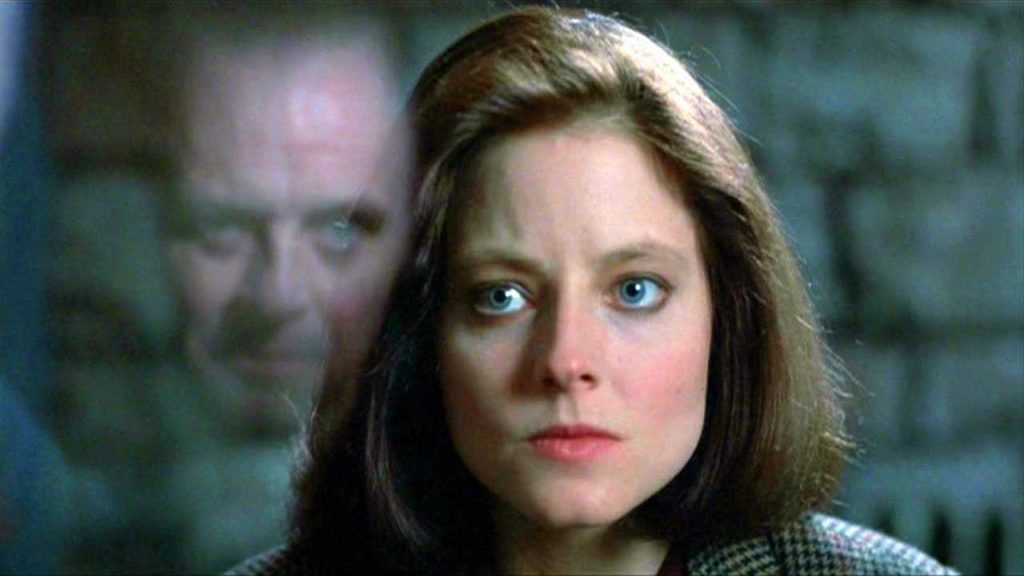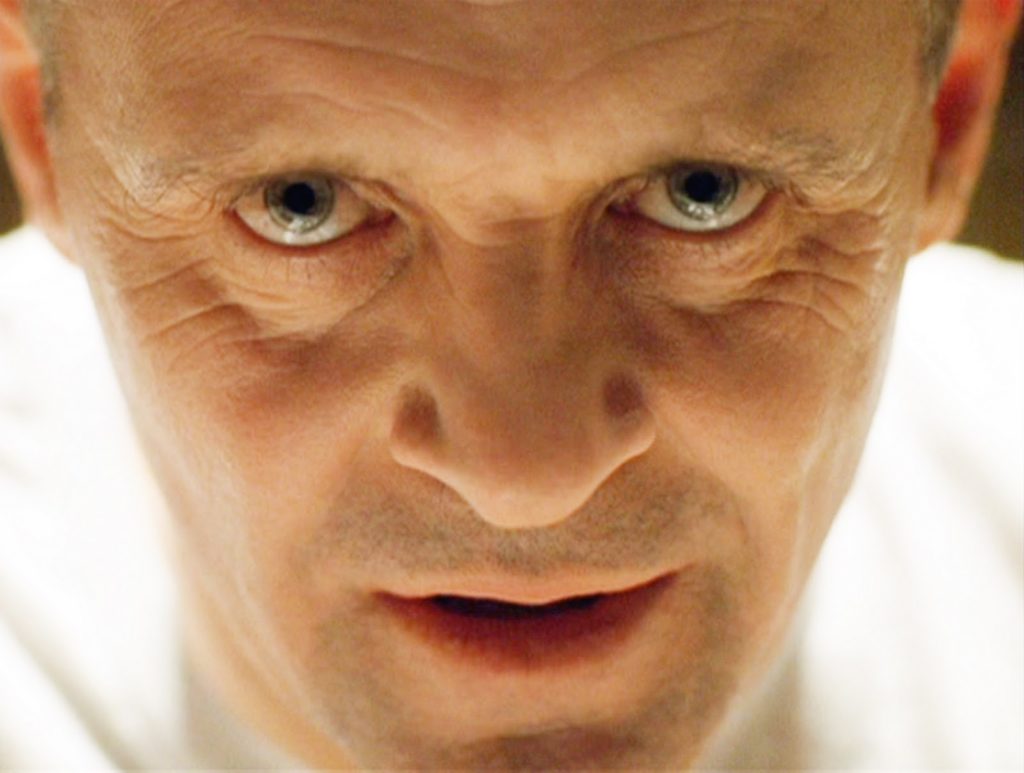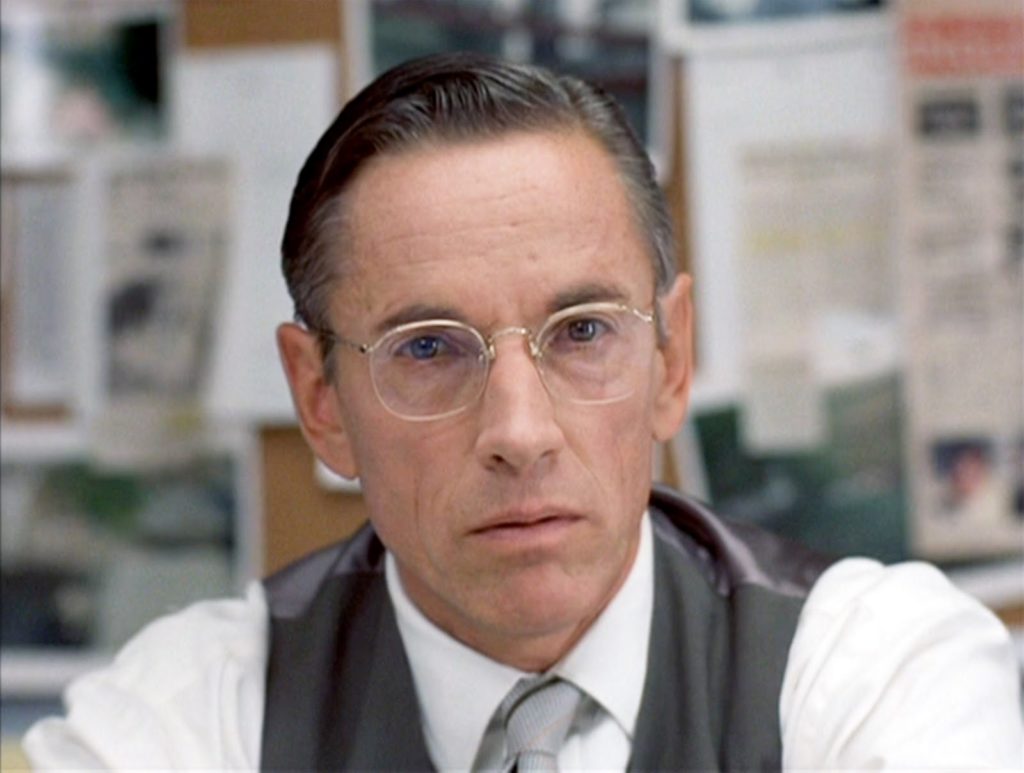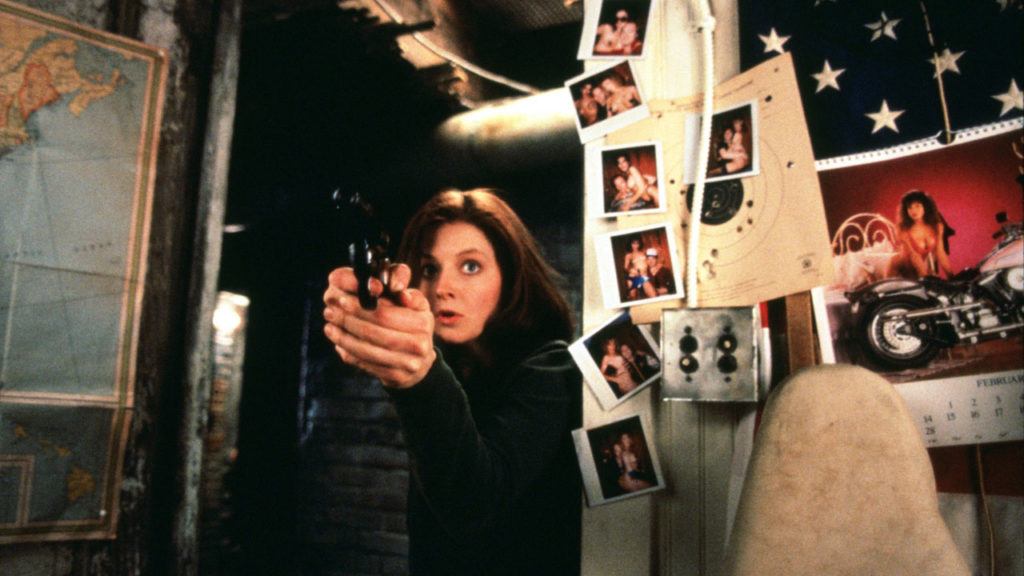Attend: Program Notes
The Silence of the Lambs | Jonathan Demme | United States | 1991 | 118 min.
Cinesthesia, Madison Public Library Central Branch, Thursday, February 7, 6:30 p.m.»
Director Jonathan Demme gives the psychological horror thriller a distinctively feminist twist in his acclaimed adaptation of Thomas Harris’s bestselling novel, The Silence of the Lambs.
At once a detailed, authoritative law-enforcement procedural, a disturbing gothic horror story, a stark psychological thriller, and an unflinching descent into the darkest recesses of the human mind, The Silence of the Lambs remains a landmark of American cinema and an unparalleled cultural phenomenon.

Adapted from the bestselling 1988 novel by Thomas Harris, Jonathan Demme’s film focuses on the strange relationship between Clarice Starling (Jodie Foster), an ambitious, bright young FBI trainee, and Dr. Hannibal Lecter (Anthony Hopkins), a sophisticated, diabolical, and calculating former psychiatrist with a taste for human flesh. Starling visits the notorious mass murderer in a maximum-security hospital for the criminally insane, where he has been confined for life. On an assignment from Jack Crawford (Scott Glenn), director of the FBI’s Behavioral Science Unit, she hopes to gain insight into the mind of an active serial killer nicknamed “Buffalo Bill” who inexplicably starves and skins his victims. When Bill abducts the daughter of a powerful senator from Tennessee, Starling finds herself in a race against time. Desperate to save the woman, she reluctantly agrees to reveal personal information about herself in exchange for cryptic clues to the identity of Buffalo Bill. As Starling learns to play Dr. Lecter’s intricate mental games, she must confront not only the monsters of the world, but also her own inner demons.
Thomas Harris created Dr. Lecter for his page-turner Red Dragon (1981), in which a male veteran FBI investigator is brought out of retirement to track down a serial killer, consulting with the convicted mass murderer to gain more insight into his subject. Lecter remains a peripheral character in the first book, while Harris does not mention the epicurean cannibalism that came to define his charismatic anti-hero. The sequel to Red Dragon proved as big a literary sensation as its predecessor seven years earlier. Harris had spent five years planning and writing The Silence of the Lambs, conducting in-depth research at the FBI’s Department of Behavioral Science. Author Clive Barker declared, “Thrillers don’t come any better than this. It takes us to places in the mind where few writers have the talent or sheer nerve to venture.”
A larger-than-life, almost supernatural creature akin to Bram Stoker’s Count Dracula, Lecter has become a popular icon of the late twentieth century with his keen intellect, verbal dexterity, refined sensibilities, and savage behavior. The most famous incarnation of Lecter, Anthony Hopkins presents a chilling portrait of the archetypal villain. Reviewing the film version of The Silence of the Lambs in the Evening Standard, Alexander Walker suggested that “It’s the combination of high intelligence and primitive appetite that makes Lecter such an uncomfortable character.” Financial Times critic Nigel Andrews described the Doctor as “Stone Age man and Renaissance man rolled into one.” In other words, Lecter perfectly embodies what Swiss psychiatrist Carl Gustav Jung recognized as the duality of human nature.

While Lecter came largely from Harris’ imagination, the antagonist of The Silence of the Lambs, Buffalo Bill (also known as Jame Gumb) evidently represents a composite of three real-life serial killers: Ed Gein, Ted Bundy, and Gary Heidnick, all of whom preyed on women. Gein skinned and dismembered his victims, wearing the hides and using the other body parts as house decorations. Bundy lured victims by putting a phony cast on one arm and asking for help. Heidnick held his victims captive in a basement pit.
Although Harris’ book attracted a lot of interest from filmmakers, The Silence of the Lambs initially seemed just too bleak for movie material. At one point, the film rights were held by director John Badham, whose career had taken off with the John Travolta disco smash Saturday Night Fever (1977). Despite his relatively strong commercial track record, every studio he approached turned him down flat, citing the unsavory subject matter. As one studio executive put it: “Nobody wants to see a movie about skinning women… I have no intention of making The Silence of the Lambs.” Badham therefore sold his option on the film rights. Orion Pictures acquired the project when actor Gene Hackman (The French Connection) expressed a strong interest. Intending to make The Silence of the Lambs his directorial debut and possibly star in the film as Lecter, Hackman eventually passed on it, feeling it was too violent. In the end, the project went to Jonathan Demme, an up-and-coming young director who had made two previous films for Orion, including Something Wild (1986) and the recent hit Married to the Mob (1988).
When it came to casting the role of Clarice Starling, Demme and Orion boss Mike Medavoy wanted Michelle Pfeiffer, star of Married to the Mob. Still at the peak of her career, the actor agreed to read Ted Tally’s script for The Silence of the Lambs, only to express a strong dislike for the bleak subject matter. As Demme put it: “she was unable to come to terms with the overpowering darkness of the piece.” Pfeiffer had serious reservations about what she considered the film’s “glorification” of evil. Jame Gumb, the lowlife psychopath hunted down by Starling, did not present a problem, since the character was portrayed as a warped, loathsome figure throughout the film and ultimately defeated. Lecter, on the other hand, signified the apparent triumph of darkness, being a magnetic, quick-witted serial killer who cunningly escapes his jailers. Nevertheless, Pfeiffer admired Hopkins’s performance in the finished film.
Jodie Foster had read Harris’s’ novel and immediately recognized Clarice Starling as an ideal role. In her opinion, this would be a Hollywood first. Foster approached Tally and expressed her strong interest in the part. She had offered her services to Demme as a possible substitute if Pfeiffer passed on the role, but the director felt she lacked the necessary versatility for Starling. His next choice was Meg Ryan. Yet Foster met with Demme in New York and convinced him that she both understood and appreciated the dark, disquieting tone of the film, which she connected with on a “serious personal” level. The director respected her approach to the role: “Her identification was with a character who felt deeply for victims.”
Demme had seen David Lynch’s The Elephant Man (1980), in which Anthony Hopkins plays eminent Victorian surgeon Frederick Treaves, a pioneer of medical science with a strong sense of humanity who discovers and helps a grotesquely deformed individual performing as the star attraction of a freak show. Interviewed by Saskia Baron for the BBC’s Late Show arts program in May 1991, Demme explained the choice of Hopkins for the part of Lecter: “Anthony Hopkins appears to be exceptionally intelligent; there’s something about his face, something about his eyes, something about the way he expresses himself.” The director wanted Lecter to possess both intelligence and humanity, rendering the character more than just “a brilliant icicle.” Hopkins certainly seems to have been his first choice for the part. A longtime fan of the actor, Demme felt that Dr. Lecter represented the inverse of his compassionate Dr. Treaves in The Elephant Man. He sent Hopkins a copy of the script, which the actor skimmed through. Nevertheless, he felt from the outset that The Silence of the Lambs would “touch the pulse of people.”
Hopkins realized immediately that Lecter was the kind of role that comes along only once in a lifetime. In an interview with the actor featured in Inside the Labyrinth, a 2001 documentary by Jeffrey Schwarz on the making of The Silence of the Lambs, Hopkins explains his relationship to the character of Lecter.
I understood the man and how to play him. I knew he was the shadowy figure that lurks inside all of us. And I don’t know why I have an instinct about those things, but I do. I’m fascinated by the shadow side of our psyches, because they are also the most creative sides of us. And if we deny . . . the dark side of our nature, we live a pretty bland life or a destructive life because it will come out in the end in some form or another.
Cast in the role of Clarice’s mentor, Jack Crawford, actor Scott Glenn was determined to do his character justice. He therefore went to Harris’s original inspiration for Crawford, John Douglas, now head of the FBI’s Investigative Support Unit. Serving as the Bureau’s senior official consultant on The Silence of the Lambs, Supervisory Special Agent Douglas agreed to spend time with the actor, coaching him in the role.
To prepare for the part of Clarice Starling, Jodie Foster spent two weeks at the FBI training academy in Quantico, Virginia, where co-stars Scott Glenn and Ted Levine also did some background research. Foster partially based the role of Starling on one of their guides, FBI special agent Mary Ann Kraus. Her determination to make the character as authentic as possible involved looking at grisly crime scene photographs and attending the autopsy of a female murder victim. She reportedly declined to join Glenn when John Douglas played him the taped screams of two young women as they were tortured to death.

Demme understood that The Silence of the Lambs was first and foremost the story of Clarice Starling, a woman fiercely dedicated to saving the lives of other women. Harris’s novel neither dwells on Jame Gumb’s gruesome activities nor makes him at all sympathetic. Tally’s screenplay for the film, which remains relatively faithful to the source material, removes the emphasis from the serial murderer. In a 1991 interview with film critic Amy Taubin for the Village Voice, Demme remarked, “One of the great things about the script is its genre base. It’s a suspense movie with a female protagonist who’s never in sexual peril. It’s a slasher movie that’s devoid not only of slasher scenes, but of the anticipation of seeing them.” While Starling does not appear in every scene of The Silence of the Lambs, Demme aimed to tell the tale from her point of view. He and director of photography Tak Fujimoto employed a subjective camera to force identification with the character and show exactly what she sees. The scenes between Lecter and Clarice are shot in extreme close-up, with the actors looking almost directly into the camera.
Finding the proper approach to the depiction of sadistic violence in The Silence of the Lambs was one of Demme’s principal concerns during pre-production. Along with Ted Tally, production designer Kristi Zea, and Tak Fujimoto, the director strived to remain faithful to Harris’s book without repulsing the audience. Since much of the novel’s power derives from horrific, clinically described detail, Demme did not want to dilute the material for the sake of tastefulness. He opted to show some extremely graphic images in brief, almost split-second shots. There would be no lingering close-ups of flayed faces or decayed flesh.The film achieves a delicate balance, neither sanitizing nor glamorizing the grim reality of serial murder.
Filmed on a modest budget of $22 million, The Silence of the Lambs opened in theaters on February 13, 1991, a day before St. Valentine’s Day. Despite being released by a smaller studio during the typically weak post-Christmas period, the film was remarkably well received by both audiences and critics. By the end of its initial release, The Silence of the Lambs had earned more than $130 million in North America, and its worldwide box-office take of $250 million equaled that of Tim Burton’s mega-hit Batman (1989). Most surprisingly, its recognition by the Academy of Motion Picture Arts and Sciences was virtually unprecedented. At the sixty-fourth Academy Awards in 1992, Demme’s film swept the top five awards.
The Academy members honored The Silence of the Lambs with the awards for Best Picture, Best Director, Best Actor in a Leading Role (Hopkins), Best Actress in a Leading Role (Foster), and Best Adapted Screenplay (Tally). Only two previous films had ever won in all of those categories—the 1934 Frank Capra film It Happened One Night and Milos Forman’s One Flew Over the Cuckoo’s Nest (1975).
Handed the award by Michael Douglas, Jodie Foster’s acceptance speech included the words: “Thanks to the Academy for embracing such an incredibly strong and beautiful feminist hero that I’m so proud of.”
Partly as a reaction to the overwhelming accolades heaped upon The Silence of the Lambs, the movie became embroiled in a spectacular controversy. At the Academy Awards, hundreds of protestors from various gay rights and advocacy groups such as Queer Nation disrupted the entrance to the gala event by chanting, picketing, defacing the giant golden Oscar statues with stickers reading “Fag,” and even throwing objects at those on the red carpet. At least eleven protestors were reportedly arrested as “police in riot gear and on horseback interposed themselves between the demonstrators and the pavilion.” The events surrounding the ceremony, as a New York Times reporter put it, “resembled a barricaded war zone in which police, the paparazzi, and demonstrators engaged in running skirmishes.”
The protest, which had begun hours before the ceremony and continued until after the awards show was finished, had been threatened for weeks. At the root of this controversy was what Judy Sisneros, a leader of Queer Nation, called “Hollywood homophobia.” The AIDS crisis, which had come to national prominence in the mid-1980s, had provoked a dramatic rise in gay, lesbian, and transgender activism. By the early 1990s, numerous groups such as ACT-UP and Queer Nation were taking increasingly vocal stands against legal and cultural forms of discrimination, and Hollywood had become one of the targets.
The real provocation for the action against the Academy Awards, however, came from two Oscar-nominated films: Oliver Stone’s JFK, for its negative portrayal of gay characters, and The Silence of the Lambs. The harsh condemnations of Demme’s film were largely due to the suggestion that Buffalo Bill was a homosexual. For some gay male critics, the vicious serial killer was another in a long line of homophobic representations. Nonetheless, Demme insisted that Bill’s pathological efforts have nothing to do with being gay. “If you don’t understand that this guy isn’t gay, you don’t understand the story. It’s about a man who doesn’t want to be a man, he wants to become as different from himself as he can.”
Although some in the gay and lesbian community vilified The Silence of the Lambs for its alleged homophobic overtones, many feminist critics hailed it as an important, empowering work. For instance, Amy Taubin thought The Silence of the Lambs, in its “uncompromising feminism,” subverted the typical gender politics of the horror movie. She also pointed out that “the collaboration between Tally, Demme, and Foster transforms Clarice into a more radically feminist character than she was in the novel.” Judith Halberstam observed that the film “undermines the murderous gaze of patriarchy.” B. Ruby Rich noted that the film declines to eroticize violence “by removing any sense of sex from its depiction of violence.”

With its evocative, cathartic mingling of fantasy and realism, sustained structural clarity, sensitivity to the feminine perspective, and powerful, nuanced performances, The Silence of the Lambs elevates the horror genre to the realm of high art, while offering an immensely entertaining cinematic experience. For a film dealing with mass murder, torture, cannibalism, extreme violence against women, and human flesh wardrobes, The Silence of Lambs remains remarkably palatable throughout. Even when it probes the depths of depravity, the film eschews sensationalism and reveals a profoundly humanistic outlook. Despite Demme’s achievement of astounding popular and critical success with a complex, courageous female protagonist overcoming the barriers of patriarchy, the American film industry, alas, has not yet followed the precedent of Agent Starling. At any rate, the world is indeed more interesting with her in it.